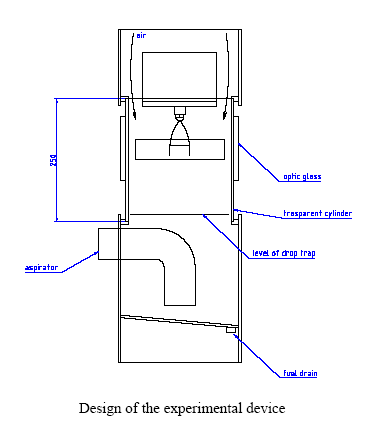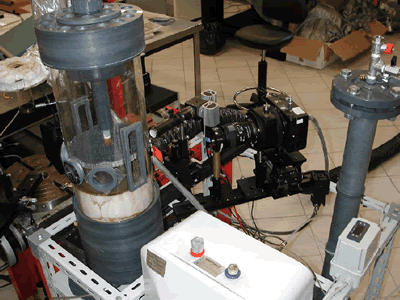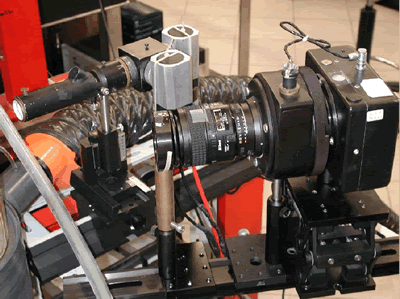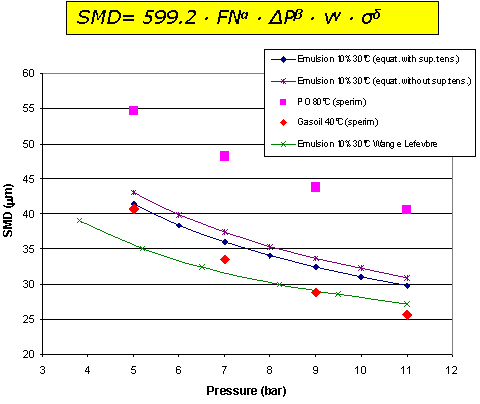 |
TESTS WITH A PO EMULSION IN SMALL BOILERS
A test rig was designed and built to analyse the effect of PO in standard diesel oil pump typically used in domestic burners/heaters.The equipment is basically composed by the following main elements:
· Gear pump
· Electrical motor
· Nozzle or valve
· 2 transparent tanksThe used gear pump has the following characteristics:
· Working pressure 9 bar
· 42 l/h delivered at the working pressure conditions
The pump is equipped with a built-in pressure keeping valve (adjustable within the range of 7-14 bar). The regulation of this valve can be adjusted at the beginning of the test on the basis of the pressure indicator. The pump delivers the fuel to a nozzle that sprays the fuel in the combustion chamber. In the test rig the nozzle is used only for short periods of time in order to avoid fuel vaporization and volatilisation, which would affect the results of the experimental work by modifying the fuel characteristics. During normal operation of the test rig the pressure drop caused by the injector is instead simulated by a valve which can be regulated.
Further than the aggressive nature of the PO, one of the main problems when pumping pyrolysis oil is the poor lubrication, since PO does not have the same lubrication properties as LFO.
Transparent tanks were selected, in order to check the spray angle (only for very short period of time when the gear pump is switched on). Differences in viscosity can change the spray angle as well as the droplet size.
Pressure and temperatures were recorded during the pump test. The pressure gauge showed the changes in pump performances in time. The temperature was mainly used as reference and additional control parameter.
In case the pressure falls below 7.2 bar, the test is automatically interrupted, as under this conditions the spray wouldn’t be of acceptable quality.
Light fuel oil (LFO) was used first in order to carry out a complete check of the equipment and to have a reference case being the fuel generally used.
The pump test rig was run with an emulsion 10 % w/w PO in LFO to study the compatibility with the carbon steel pump.
After 20 hours the pressure was not stable anymore and at 41 hours the pressure dropped below 7 bar, then the system automatically switched off the pump. It was caused by the pressure regulating valve as the piston was stuck on its seat. Also the pump shaft was stuck on the seat. All the components of the pump, carbon steel made, were corroded.
Tests indicated that under high speed motion (such as between two sliding surfaces with very small clearance), PO, even in emulsion and regardless the percentage, starts to attack standard materials, to stuck to the surfaces and act as a glue, increasing friction and absorbing mechanical work.
Therefore, it seem very difficult to use emulsion in such low cost standard LFO gear pump without any kind of modification.
The most affected items after the test were the drive shaft, the pressure regulating valve, while the revolving gears didn’t seem very affected in such a short time.As a side activity, preliminary sticking tests were also performed to investigate if PO and PO/LFO emulsion stick on surfaces spontaneously.
Three different items (two for each type ) were prepared for tests:
· Stainless steel
· Carbon steel
· Stainless steel, after 16 hrs soaked in hydrochloric acid 7,5%They were soaked into two vessels, one containing pure PO, the other 10% PO/LFO emulsion. The test was concluded after 96 hrs.
On stainless steel there was no visible attack by the acids and no sticking was observed (no differences between pure PO and emulsion).
On carbon steel there were signs of attack, but still no spontaneous sticking was observed.
The third test was planned in order to investigate if the surface characteristics, such as porosity and roughness, would have affected PO deposit on surfaces. The behaviour was the same as for normal stainless steel.
It is also possible that the test time was not sufficient to initiate the sticking process.
This additional test confirmed that the motion conditions are fundamental for accelerating the attack operated by PO and PO emulsions to mechanical components.
The influence of pressure on the behaviour of stainless and carbon steel surface was also investigated filling a tank with pyrolysis oil and keeping under pressure by means of compressed air.
A 90 hours test at 8 bar was carried out and no major visible changes in stainless steel were observed, while the carbon steel was attacked.
During a longer 513 hours test at 10 bar, stainless steel was not affected, carbon steel was more corroded and spring steel was not attacked in the part soaked in the liquid, while it was damaged in the emerging part.
The conclusion is that pressure seems not to influence the materials behaviour.An electro-chemical nickel coating, called Niploy process, was then applied to all the items in contact with the emulsion in order to verify the possibility of achieving 500 hrs of continuous operation.
After several trials it was not possible to nickel plate the gears and maintain the same clearances (i.e. the same performances).
A rotary vane pump gave good results, but an additive, such as ethanol, had to be mixed because of loss in auto-lubricating properties of graphite due to the high viscosity of PO.
Even a small percentage of ethanol (such as 1%),which makes PO less sticking and less viscous, has been enough to allow for a good operation of the pump: it has been running continuously for 22 days, then the test was stopped.
The main results from the pump tests have been:
• Chemical attack of carbon steel parts of the pump;
• AISI 316 and 304 materials stand PO;
• Graphite stands PO, but even small percentages of PO in diesel oil makes this material loose its self-lubricating properties;
• Adding small quantities of ethanol to PO reduces PO viscosity and deposit formation.
Therefore possible solutions could be:
• investigating the best additive for pump protection,
• building the pump gears in a corrosion resistant material, increasing considerably the cost.
The adoption of stainless steel material for the more sensitive components, which could be a possibility, nevertheless has to be proven over long term operation.
Spray Investigation
In order to investigate the spray properties an experimental spray test rig has been designed and set-up by CSGI and the equipment and facilities (laser and optical measurements) available at IM have been used for the investigation.
The spray test rig is aimed at investigating the droplet size and distribution when using PO/LFO emulsion as fuel for small scale heating boilers.
The pump-injector system is installed in the equipment in such a way that the spray occurs in a flow-controlled and closed environment, where a laser beam is used to investigate the droplet characteristics. The composition of the droplets is also expected to be roughly examined.
PO vapours are then collected, as well as liquid PO, from the bottom of the spray rig.


Top view of the spray test rig (on the left) and particular of the optical measurements system (on the right)
A correlation model has been defined and compared with data available on literature for pure PO, LFO and water. The model uses the following parameters: pressure drop, nozzle Flow Number, kinematik viscosity and surface tension.
Cold spray experiments as well as theoretical work has been performed.
From the theoretical point of view, the spray phenomenology has been described, literature reviewed and main parameters investigated. Correlations able to describe fuel spray have been analyzed and compared with experimental data for PO and LFO (not emulsified) sprays available in literature, and a new one specifically proposed for PO/LFO emulsions.
Fuel flow rates using emulsions have been modelled according to main operational parameters and nozzle characteristics, in order to estimate thermal power in the burner and related boiler working conditions. For instance, to maintain the same thermal power in the boiler when using LFO at 7 bar fuel pressure requires 11 bar fuel pressure in then nozzle if a 20 % w/w PO in LFO emulsion is considered.
From the experimental analysis of PO/LFO emulsions several parameters relevant in spray modelling were inferred. They are:
i) the spray cone angle;
ii) the droplets size distribution;
iii) the mean and the Sauter mean diameters.Images of the spray at different pressures (48 bar) have been taken for water, LFO and POLFO 10 % w/w emulsions. Spray angle increases with pressure for LFO and emulsions, while it is almost constant with water: sprays of emulsions however show larger cone angles (approximately 17 % average increase in cone angle) compared to pure LFO.
Size distributions of droplets measured in sprays of water, light diesel oil and PO emulsion at injection pressure of 0.8 MPa, as well as mean diameter and Sauter mean diameter have been measured and calculated: emulsions showed slightly smaller mean and Sauter mean diameters compared to pure LFO.




